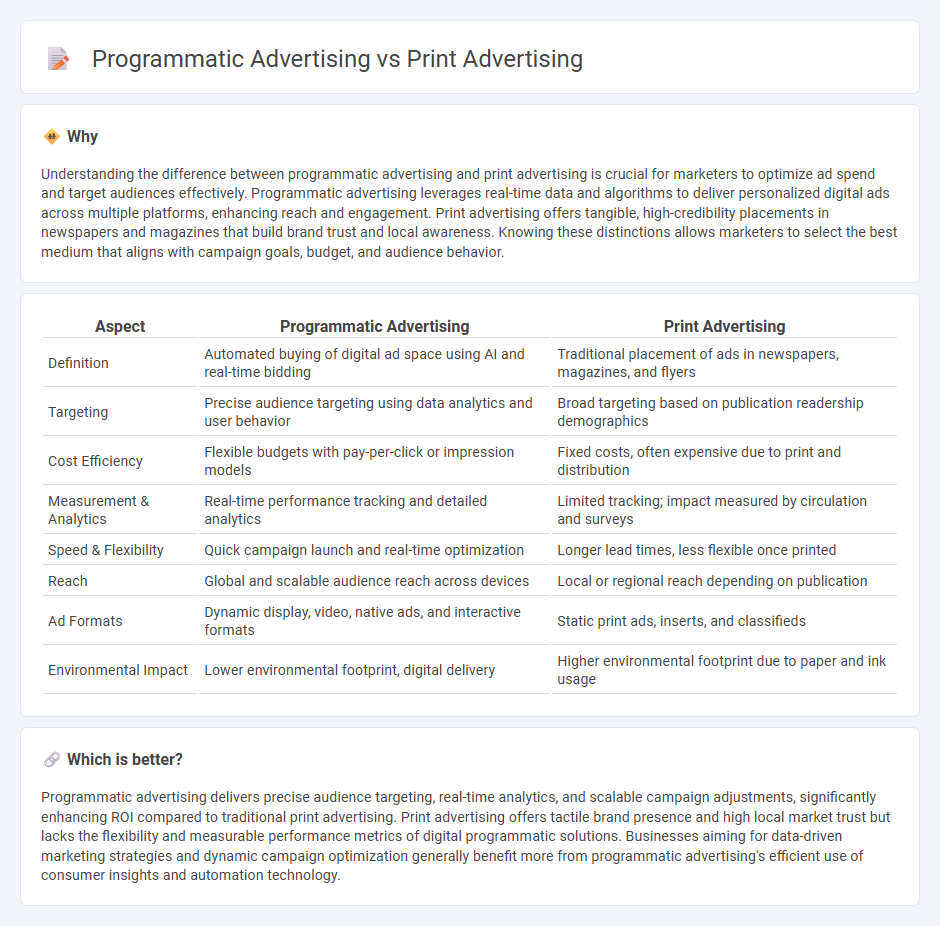
Programmatic advertising uses automated technology to buy digital ad space in real time, targeting specific audiences with precision and data-driven insights. Print advertising relies on traditional methods, placing ads in newspapers, magazines, or brochures to reach a broad or localized demographic. Explore how each method influences campaign effectiveness and audience engagement to determine the best strategy for your marketing goals.
Why it is important
Understanding the difference between programmatic advertising and print advertising is crucial for marketers to optimize ad spend and target audiences effectively. Programmatic advertising leverages real-time data and algorithms to deliver personalized digital ads across multiple platforms, enhancing reach and engagement. Print advertising offers tangible, high-credibility placements in newspapers and magazines that build brand trust and local awareness. Knowing these distinctions allows marketers to select the best medium that aligns with campaign goals, budget, and audience behavior.
Comparison Table
| Aspect | Programmatic Advertising | Print Advertising |
|---|---|---|
| Definition | Automated buying of digital ad space using AI and real-time bidding | Traditional placement of ads in newspapers, magazines, and flyers |
| Targeting | Precise audience targeting using data analytics and user behavior | Broad targeting based on publication readership demographics |
| Cost Efficiency | Flexible budgets with pay-per-click or impression models | Fixed costs, often expensive due to print and distribution |
| Measurement & Analytics | Real-time performance tracking and detailed analytics | Limited tracking; impact measured by circulation and surveys |
| Speed & Flexibility | Quick campaign launch and real-time optimization | Longer lead times, less flexible once printed |
| Reach | Global and scalable audience reach across devices | Local or regional reach depending on publication |
| Ad Formats | Dynamic display, video, native ads, and interactive formats | Static print ads, inserts, and classifieds |
| Environmental Impact | Lower environmental footprint, digital delivery | Higher environmental footprint due to paper and ink usage |
Which is better?
Programmatic advertising delivers precise audience targeting, real-time analytics, and scalable campaign adjustments, significantly enhancing ROI compared to traditional print advertising. Print advertising offers tactile brand presence and high local market trust but lacks the flexibility and measurable performance metrics of digital programmatic solutions. Businesses aiming for data-driven marketing strategies and dynamic campaign optimization generally benefit more from programmatic advertising's efficient use of consumer insights and automation technology.
Connection
Programmatic advertising leverages automated technology to purchase digital ad space, enabling precise targeting and real-time data analysis, which complements the broad reach and tangible brand presence offered by print advertising. Integrating programmatic strategies with print campaigns enhances cross-channel marketing effectiveness by driving digital engagement alongside physical media exposure. This combined approach maximizes return on investment through synchronized audience targeting and consistent brand messaging across both digital and traditional platforms.
Key Terms
Targeting
Print advertising offers limited targeting capabilities, relying primarily on demographics and geographic distribution to reach audiences. Programmatic advertising uses real-time data and algorithms to deliver highly personalized ads based on user behavior, interests, and online activity. Explore how advanced targeting techniques in programmatic campaigns can maximize your advertising ROI.
Ad Placement
Print advertising offers targeted placement in specific magazines or newspapers, reaching a defined audience based on publication demographics and geographic distribution. Programmatic advertising automates ad placement across digital channels using real-time data, allowing precise audience targeting and dynamic optimization for higher engagement. Explore the advantages and strategies of both ad placements to maximize your marketing impact.
Cost Efficiency
Print advertising requires significant upfront costs for design, printing, and distribution, often limiting its flexibility in budgeting and targeting. Programmatic advertising uses automated bidding processes and real-time data to optimize ad spend, achieving greater cost efficiency by targeting specific audiences and reducing waste. Explore how shifting your marketing budget to programmatic advertising can maximize ROI and reduce overall expenses.
Source and External Links
Print Advertising: Why It Still Matters in the Digital Age - Discusses the advantages of print advertising, including its tangible nature, targeted reach, and lasting impact.
Print Advertising - Explains the benefits and limitations of print advertising, emphasizing audience targeting and visual design.
The Ultimate Guide to Print Advertising - Provides a comprehensive overview of print advertising, including its types, benefits, and examples of effective print marketing.
 dowidth.com
dowidth.com